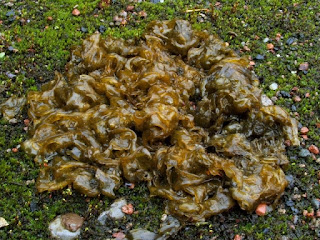You
read that right. Throughout the world, on dry bare ground, you can find little
black crusts. When it rains, these crusts swell up and become greenish. They do
look like greenish-black snot, or, as I prefer to think, like something
produced by an animal that had an emergency with one or the other end of its
alimentary canal. Ancient people, with more imagination than knowledge, made a
wild guess that these snotty crusts came from meteors, asteroids, etc. Star
snot. Or, more politely, star jelly. See my video about it.
You read that right. Throughout the world, on dry bare ground, you can find little black crusts. When it rains, these crusts swell up and become greenish. They do look like greenish-black snot, or, as I prefer to think, like something produced by an animal that had an emergency with one or the other end of its alimentary canal. Ancient people, with more imagination than knowledge, made a wild guess that these snotty crusts came from meteors, asteroids, etc. Star snot. Or, more politely, star jelly.
What they actually are is thick patches of the cyanobacterium Nostoc commune. Cyanobacteria are a group of photosynthetic bacteria. In fact, they have the same kind of photosynthesis that you find in plant chloroplasts. In fact, chloroplasts are the evolutionary descendants of cyanobacteria. Not only are they single cells, but they are simple cells, without a nucleus or internal structures. Not having roots, stems, or leaves, the only place they can grow is in water or on bare ground. These cyanobacteria have the ability to dry up and wait for the next rain.
Cyanobacteria, like a few other bacteria, have the ability to “fix” nitrogen, that is, to transform atmospheric nitrogen gas into ammonium fertilizer. Because of this, cyanobacteria can live in places (such as surfaces of dry soil) that are deficient in nitrogen. Even though the Nostoc is not trying to fertilize the soil, it ends up doing so, because some of the ammonium leaks out. Nostoc fertilizes the soil. Eventually, other plants can grow in this enriched soil and drive out the Nostoc. The Nostoc then disperses into the wind, and some of them may land on a new patch of dry soil and start to grow again.
I
never noticed star snot before. It was doing important work, and I, despite
doctoral-level botanical training, knew nothing about it.


No comments:
Post a Comment